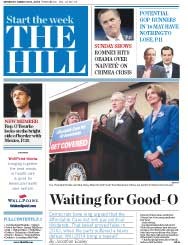By Benjamin Goad - 08/23/13 06:28 PM EDT
The Occupational Safety and Health Administration (OSHA) on Fiday issued draft regulations aiming to limit workers’ exposure to harmful silica dust, delivering a major victory to labor unions and safety advocates.
The proposed rule, which sat under review for more than two years at the White House, has become the poster child of stalled worker protections, with public interest and safety groups relentlessly criticizing the federal government for failing to act.
Silica dust is commonly released at construction sites, shipyards and other workplaces where heavy machinery is used. It has been associated with numerous ailments, including silicosis and lung cancer.
Once implemented, the new regulations would save nearly 700 lives per year and prevent 1,600 new cases of silicosis annually, according to OSHA estimates.
“Exposure to silica can be deadly, and limiting that exposure is essential,” said David Michaels, assistant secretary of labor for occupational safety and health. “Every year, exposed workers not only lose their ability to work, but also to breathe.”
The proposal follows years of analysis, public meetings and an intense lobbying effort.
The debate over tougher silica standards date back to the 1970s, when the National Institute for Occupational Safety and Health (NIOSH) recommended that the limit be significantly reduced. The group determined that crystalline silica is “associated with silicosis, lung cancer, pulmonary tuberculosis and airways diseases.”
Industry groups were split on the proposal.
The National Industrial Sand Association, which has opposed efforts to toughen the current standard, said that stronger exposure limits weren’t necessary.
“Because our companies have successfully protected their workers under the current permissible exposure limit (PEL), we do not believe there is a proven need to lower that level and disagree with OSHA’s proposal to cut that limit in half,” said Mark Ellis, the organization’s president, in a statement.
He added that the group supported others aspects of the proposal, including requiring medical surveillance and monitoring of workers' exposure to the dust.
The National Asphalt Pavement Association, however, said in a statement that the asphalt industry “is positioned to meet the new standard.”
In 2011, a report from a working group created by the American Chemistry Council (ACC) estimated the overall economic impact of new standards at almost $5.5 billion and said they would cost industry upwards of $30 million in lost output over 10 years, while eliminating 170,000 jobs.
Public interest groups, who argued that health risks far outweighed the cost, heralded the action as a possible signal of a shift at the White House’s regulatory office.
“I hope that this portends a new approach by the Office of Information and Regulatory Affairs and the Office of Management and Budget, a new approach toward allowing regulations out in an expeditious fashion,” said Tom McGarity, a professor at the University of Texas Law School.
The proposal is one of the first major rules to emerge from the White House’s Office of Information and Regulatory Affairs since new administrator, Howard Shelanski, took over in July.
Once the rule is published in the Federal Register, the public and interested parties will have 90 days to submit written comments before a series of public hearings are convened.
Only after those steps will the agency issue a final rule.
Julian Hattem contributed to this story.
This story was updated at 3:48 p.m.

